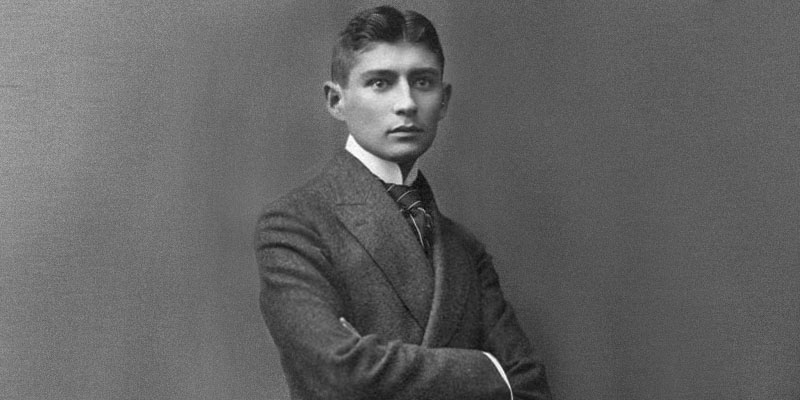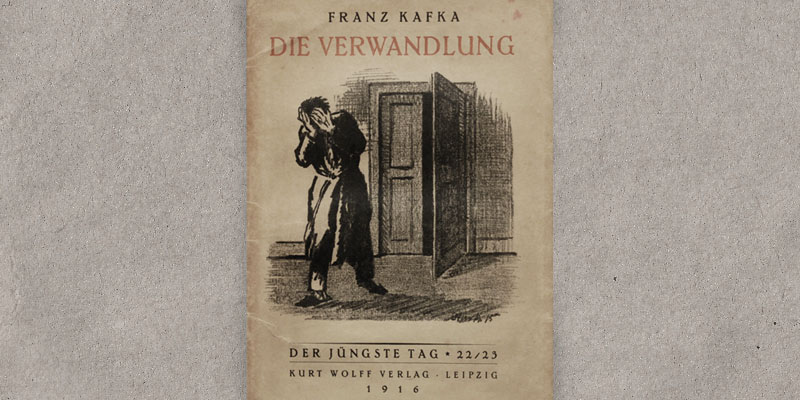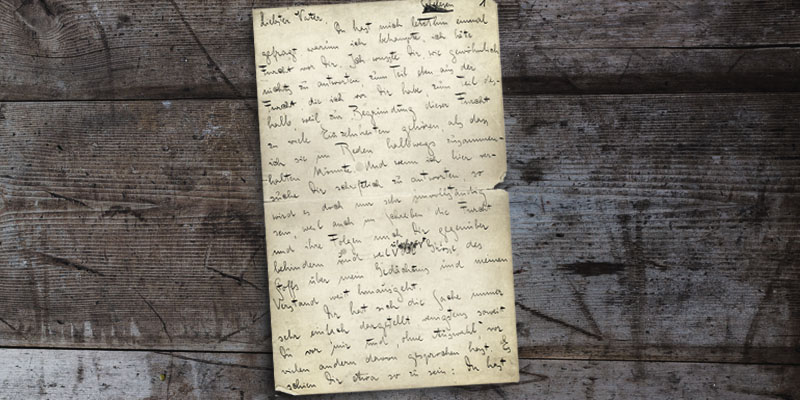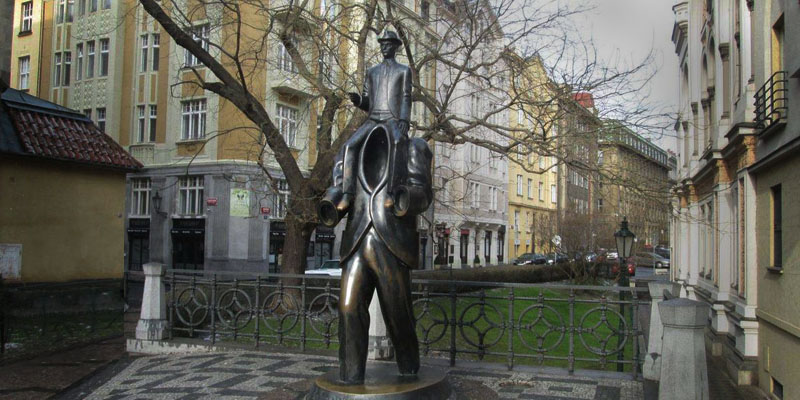We explore the life and work of Franz Kafka, and discuss why he is regarded as a key figure in 20th-century literature.

Who was Franz Kafka?
Franz Kafka was a Czech writer whose body of work, written in German, is considered key to 20th-century literature and among the most influential in modern literature. He was the author of novels and numerous short stories, as well as of aphorisms and even screenplays.
Kafka's works are enigmatic and obscure, often sparking debate among critics and scholars regarding their interpretation. Nevertheless, such is his significance and so unique is his style that the adjective Kafkaesque has been coined to describe situations similar to those he often explored in his works, namely oppressive, distressing, absurd, and inevitable.
While the Kafkaesque style is difficult to classify, it is usually regarded as being close to expressionism and existentialism. Authors as diverse as Albert Camus, Gabriel García Márquez, and Jorge Luis Borges have acknowledged the influence of Kafka's writings on their own careers.
Kafka is also noted for his tormented life and premature death. On his deathbed, he requested his best friend, Max Brod, to destroy his work after he had died. Ignoring this promise, Brod posthumously published much of Kafka's work.
- See also: Victor Hugo
Birth and early life of Franz Kafka
Franz Kafka was born on July 3, 1883 in Prague, then capital of the Kingdom of Bohemia and part of the Austro-Hungarian Empire. He was the third of six children born to Hermann Kafka and Julie Löwy, both of Ashkenazi Jewish descent, who belonged to a well-off middle-class family that engaged in commerce.
The Kafka household was dominated from the beginning by the father figure, before whom the young Franz always felt subdued and helpless. At an early age, he witnessed the deaths of his two elder brothers, of whom he had always been jealous and whose deaths left him with an intense feeling of guilt. Yet, he was very close to Ottla, the youngest of his three sisters.
The family spoke Czech and German, the paternal and maternal languages, respectively. They were not devout practitioners of Judaism, attending synagogue only a few times a year.
Franz, however, admired his Hebrew intellectual heritage as much as his German one, though socially he felt isolated from both communities.
As a child, he was an obedient guilt-ridden child, devoted to his studies. In his adolescence, he entered the rigorous German State Gymnasium in Kinsky Palace in Prague’s Old Town, where he received an elite education. There, he became acquainted with the works of authors like Charles Darwin and Friedrich Nietzsche, eventually declaring himself an atheist and socialist. It was during this time that he made his early foray into literature.
In 1901 he began his studies in chemistry at Charles University in Prague, but dropped out only after a few weeks. He then tried art history and German philology, but forced by his father, he eventually enrolled in the Faculty of Law. There, he met Max Brod (1884-1968), a Czechoslovakian Jewish journalist, writer, and editor who would become his best and lifelong friend.
The "close Prague circle"

Kafka's friendship with Max Brod was, from the beginning, of great importance in the life of the young author. Brod introduced Kafka to other readers and writers and encouraged him to pursue his literary interests. Alongside journalist Felix Weltsch and writer Oskar Baum, Franz and Max formed a group that the latter christened the "close Prague circle".
The Prague circle often gathered to chat, debate, read their writings, and discuss the works of classic authors like Flaubert, Dickens, and Cervantes. Kafka's companions were also of Jewish descent and, like himself, wrote in German and identified with German culture. In this context, Kafka produced his first drafts and mingled with figures of the local scene, such as Martin Buber, Franz Werfel, Otto Pick, Ernst Weiss, Willy Haas, and Rudolf Fuchs, as recounted by Max Brod in his biography of Kafka.
In 1906, Franz completed his university studies and did a year of compulsory civil service in civil and criminal courts, performing administrative tasks. He subsequently joined an important Italian insurance company as a trainee before he finally found employment at an insurance company in 1908 (Workers' Accident Insurance Institute for the Kingdom of Bohemia), where he would work for the rest of his life.
Kafka's relationship with his office work was ambivalent. On the one hand, he was good at investigating and assessing compensation for injuries suffered by industrial workers, quickly rising through the company ranks. Moreover, the schedule allowed him some time off for writing. However, bureaucratic matters repelled him deeply, and served to feed the grim imagery of his stories.
In 1911 Kafka invested in the city's first asbestos factory alongside some relatives, an initiative to which he initially devoted his free time, but which later began to hinder his writing. Kafka was not particularly fond of his writings but felt a deep commitment to the task of writing. Between 1909 and 1912, he made several trips abroad, visiting Riva, Paris, Italy, and Weimar.
It was in 1912, at Max Brod's house that Kafka met his first love: Felice Bauer (1887-1960). In September of that same year, a month after they had met, Franz began an intense correspondence with her that lasted through their five-year relationship, culminating in their final breakup in 1917. At the end of 1912, he wrote his short story "The Judgment", dedicating it to his beloved Felice.
In his letters to Felice, Kafka not only speaks of his love for her but also of his total devotion to literature. In a letter dated January 14, 1913, Kafka writes:
"I have often thought that the best mode of life for me would be to sit in the innermost room of a spacious locked cellar with my writing things and a lamp. Food would be brought and always put down far from my room, outside the cellar's outermost door. The walk to my food, in my dressing gown, through the vaulted cellars, would be my only exercise. I would then return to my table, eat slowly and with deliberation, then start writing again at once. And how I would write! From what depths I would drag it up! Without effort!"
Excerpt from Letters to Felice (2013).
The Metamorphosis

Around 1913 Kafka developed an interest in the Yiddish and Jewish theater of the time, and began to publish his first short stories in magazines and newspapers: "The Judgment", "Contemplation", and "Consideration", among others, appeared in periodical thanks his friend Max Brod’s connections. That same year, he proposed marriage to Felice Bauer, but the wedding never materialized because the couple went through a temporary breakup, though they later reconciled.
In 1914, with the outbreak of World War I, the husband of one of his sisters was called to the front, and consequently, Franz had to take over the family business. This meant he abandoned writing for an entire year during which he was tormented by insomnia.
In 1915, his first and most renowned novel, The Metamorphosis, was published. It is a short text, about 70 pages long, narrating the sudden transformation of Gregor Samsa, a dull office worker who lives with his family, into a gigantic insect. The story first appeared in the magazine Die Weissen Blätter in October 1915, and in December it was published in book form by Kurt Wolff Verlag. Its publication was met with mixed reviews, with Kafka being accused of wanting to arouse horror and disgust among his readers.
The text, however, was translated into multiple languages over the next decade (into Spanish for the first time in 1925) and is today considered a classic story. It is often viewed as a powerful metaphor for the modern tensions facing humanity and the horrors that the 20th century would unfold, in particular for the Jewish community in Europe.
In late 1915, Franz received his draft notice to the front, but his employers arranged a deferment, considering his work an "essential government service". A couple of years later, he tried to enlist voluntarily, but was rejected for health reasons.
In 1917 he was diagnosed with tuberculosis. That same year, his final breakup with Felice Bauer occurred after another unsuccessful marriage proposal. Shortly afterwards, he was admitted to a tuberculosis sanatorium for the first time and received a disability pension from his company.
Kafka's correspondence

Kafka was an avid letter writer, though not exclusively to his first fiancée. Many of his letters to Max Brod, his sister Otta, and numerous other recipients are still preserved. In his lifetime Franz is believed to have written an estimate of about 1500 letters.
In 1919, amid the dissolution of his second engagement, Kafka wrote his Letter to His Father, a 103-page handwritten text in which he confronts his father about years of contempt and emotional abuse.
According to Max Brod’s accounts, Kafka gave the letter to his mother to be delivered, which never occurred. Kafka was alleged to have rewritten the letter several times, which remained unpublished until 1952 when it was published posthumously. Letter to His Father is deemed essential to the understanding of Kafka's work, in addition to being of great value for psychoanalytic theories.
In 1920 Franz began an intense correspondence with Milena Jesenská (1896-1944), a young Czech journalist and political activist of Jewish origin. They were introduced by Max Brod when Jesenská requested Kafka's permission to translate and publish some of his short stories. During a stay in Merano, Italy, Kafka wrote his first letters to her.
Thus started a passionate correspondence between Kafka and Milena, though as she was married, they only met in person twice. Between 1920 and 1923 they wrote to each other many letters, with Franz entrusting her with numerous writings, many of which survive today thanks to this exchange.
All the writings that Kafka entrusted to Milena Jesenská, including his letters, diaries, as well as some fragments of his literary works, were handed over by the Czech writer and translator to editor Willy Haas before she was arrested in 1939 by the Gestapo and taken to the Ravensbrück concentration camp in Nazi Germany, where she died in 1944.
Kafka’s final days

During his final years, his declining health due to tuberculosis continuously forced Kafka into sanatoriums. Nevertheless, he was able to write a significant number of short stories and complete some novels, also leaving some unfinished works behind, including The Trial.
In 1923, already fully devoted to literature, he decided to move away from his family and move to Berlin, a plan previously thwarted by the outbreak of the war in 1914. While in Germany, during a trip along the Baltic Sea coast, he met Dora Diamant, a young journalist of Jewish descent who would become his lover and companion until his death.
The couple lived in Berlin until early 1924, when Franz contracted pneumonia, which worsened leading to an attack of laryngeal tuberculosis. As a result, he returned to Prague to be admitted to a sanatorium near Vienna. The disease prevented him from eating, so he subsisted only on liquids, but he never stopped writing, even on his deathbed. Among the writings he authored in the sanatorium was his short story "A Hunger Artist," which is clearly self-referential.
Eventually, his condition deteriorated and he was transferred to a clinic in the city, where he died on June 3, 1924, at the age of 41. He was buried on June 11 in the Jewish section of the New Jewish Cemetery in Prague-Žižkov. Milena Jesenská published an obituary in his honor in the Czech newspaper Národní Listy. In in, Milena wrote:
"Dr. Franz Kafka, a German writer who lived in Prague, died the day before yesterday in the Kierling Sanatorium in Klosterneuburg, near Vienna. Few here knew him, for he was a recluse, a wise man in dread of life [...]. He was shy, anxious, meek, and kind, yet the books he wrote are gruesome and painful. He saw the world as full of invisible demons, tearing apart and destroying defenseless humans. He was too lucid and wise to live, and too weak to fight. He was weak the way noble, beautiful people are, people incapable of struggling against their fear of misunderstanding, malice, or intellectual deceit because they recognize their own helplessness in advance; their submission only shames the victor."
Days before his death, Franz received a visit from his friend Max Brod, to whom he acknowledged full awareness of his fate. He made his friend promise him to collect and destroy all his unpublished work upon his death. Max agreed, but later did not fulfill his word.
Kafka's life and work have been the subject of numerous tributes in literature and film. In addition, various monuments honor his memory, among which stands out the bronze statue erected by Czech artist Jaroslav Róna (1957-) in Prague in 2003.
Literary work of Franz Kafka

Kafka's narrative works are considered among the most significant in 20th-century literature. The cruel and terrible nature of his short stories is often interpreted as a harbinger, a literary prophecy of the horrors that would take place during the 20th century, especially with World War II. In fact, many of Kafka's Jewish relatives and friends would die years later in Nazi concentration camps.
Kafka's stories are enigmatic and obscure, whose protagonists are powerless in the face of immense and incomprehensible powers. A good example of this is Joseph K., a character from one of his two unfinished novels,The Trial, who one day is notified of the beginning of legal proceedings against him, without any clarification as to what he is accused of or the proceedings he must follow. Kafka’s characters lack sense, purpose, and solace.
Kafka's style often blends realism with the fantastic, as in The Metamorphosis, and is peculiar in its frugal and sober use of language. His tendency towards the absurd and the cruel is so recognizable that the adjective Kafkaesque has been coined to refer to situations so awkward and helpless that they seem to have been written by him.
Among Kafka's most notable works are:
Short stories
- "Before the Law" (1915)
- "The Village Schoolmaster" (1916)
- "A Country Doctor" (1918)
- "In the Penal Colony" (1919)
- "A Hunger Artist" (1924)
Novels
- The Metamorphosis (1915)
- The Trial (1925) (unfinished, posthumous)
- The Castle (1926) (unfinished, posthumous)
- Amerika (1927) (unfinished, posthumous)
Others
- Diaries (1948) (posthumous)
- Letter to His Father (1952) (posthumous)
References
- Černá, J. (1993). Kafka’s Milena. Northwestern University Press.
- Hernández, I. (2010). El mundo formidable de Franz Kafka. Ensayo autobiográfico. Revista de Filología Alemana, 18, 307-396.
- Kafka, F. (1979). The Basic Kafka. Simon and Schuster.
- Kafka, F. (2013). Cartas a Felice (trad. de Pablo Sorozábal). Nórdica Libros.
- Kafka, F. (2023). The Diaries of Franz Kafka. Knopf Doubleday Publishing Group.
- The Editors of Encyclopaedia Britannica. (2023). Franz Kafka. Encyclopedia Britannica. https://www.britannica.com/
Explore next:
Was this information useful to you?
Yes NoThank you for visiting us :)